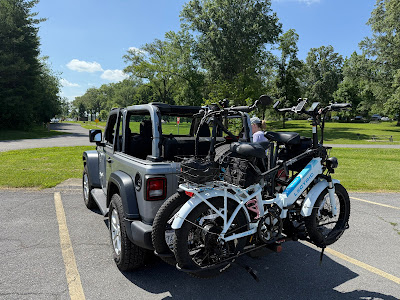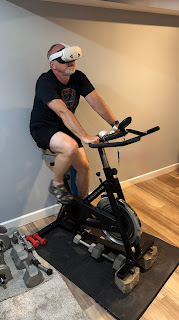I have bad knees. Not everyone has the genetic good fortune to be lifelong runners and 26 years of military service sometimes leads to worn out parts. Even biking had become difficult due to the force applied to the knees when pushing off from a stop and climbing hills. So I was left with walking.
But 2 years ago, Jennifer and I bought e-bikes. We have really enjoyed them and they have allowed us to explore many of the biking trails that are available throughout the local area. Some people are opposed to e-bikes because there are those that do not respect others on the trails and ride their e-bikes in an irresponsible manner. Others are opposed to e-bikes because they feel it is cheating in a way. They feel that because of the motor, the rider isn’t really getting much exercise and therefore they shouldn’t be allowed on the bike paths. Unfortunately they are correct that some do ride their bikes irresponsibly and risk injuring others. Having ridden many of the local trails now, I do know that many manually pedaled bike riders are able to reach very high speeds on their bicycles as well (we are often passed by these folks). If speed is the concern, it extends beyond those on e-bikes.
For me, the e-bike is an aid. The pedal assist motor isn’t about speed, it takes care of launching the bike from a dead stop so my knees don’t have to exert that initial force and increasing the pedal assist during hill climbs also removes the knee strain. On my standard bike, the normal cruising speed on a flat stretch was usually in the 12-13 mph range. On the e-bike, setting the pedal assist at 2 (out of 5) usually results in a speed around 15 mph when steadily pedaling.
This is a good video about e-biking around London that addresses many of the points I have mentioned.
Going out for a ride often involves getting the bikes loaded up and driving 10-15 miles to access the Madison County Transit Trails. These trails are great! But if I just want to get a ride in locally, we do have a very nice trail around much of our town, although not 100%.
The orange line that makes up around 80% of the bike trail is an actual protected walk/ride path. The purple line represents a residential street that is marked as shared with bikes, but the red line within the yellow box consists of residential and industrial areas that are not marked for bikes (so any of the streets in this area could be used to connect the bike trail sections) and can contain heavy traffic. I have also biked outside the city limits along rural roads. These typically are low traffic roads but cars and trucks are known to travel at much higher speeds than the city roads.
Today I purchased a new seat for my stationary exercise bike since the old seat was quite worn and the material was disintegrating. I then decided to find a virtual reality biking video on YouTube to see how riding the exercise bike inside the Meta Quest 3S would be. I know it looks a bit ridiculous, but I was eager to try it. Initially I began with a 360-degree video that was a slow ride around the Waikiki area in Hawaii. But I wanted something a little more lively, so I found a video of a ride along the streets of New York City then within Central Park. This wasn’t a 360 video, but with the Quest, I could make the screen very large and curved so it essentially encompassed not only my field of view, but my peripheral vision as well.


